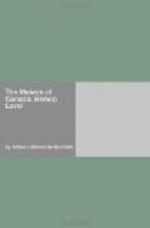M. Aubert says, on his part: “The French of Canada are well built, nimble and vigorous, enjoying perfect health, capable of enduring all sorts of fatigue, and warlike; which is the reason why, during the last war, French-Canadians received a fourth more pay than the French of Europe. All these advantageous physical qualities of the French-Canadians arise from the fact that they have been born in a good climate, and nourished by good and abundant food, that they are at liberty to engage from childhood in fishing, hunting, and journeying in canoes, in which there is much exercise. As to bravery, even if it were not born with them as Frenchmen, the manner of warfare of the Iroquois and other savages of this continent, who burn alive almost all their prisoners with incredible cruelty, caused the French to face ordinary death in battle as a boon rather than be taken alive; so that they fight desperately and with great indifference to life.” The consequence of this judicious method of peopling a colony was that, the trunk of the tree being healthy and vigorous, the branches were so likewise. “It was astonishing,” wrote Mother Mary of the Incarnation, “to see the great number of beautiful and well-made children, without any corporeal deformity unless through accident. A poor man will have eight or more children, who in the winter go barefooted and bareheaded, with a little shirt upon their back, and who live only on eels and bread, and nevertheless are plump and large.”
Property was feudal, as in France, and this constitution was maintained even after the conquest of the country by the English. Vast stretches of land were granted to those who seemed, thanks to their state of fortune, fit to form centres of population, and these seigneurs granted in their turn parts of these lands to the immigrants for a rent of from one to three cents per acre, according to the value of the land, besides a tribute in grain and poultry. The indirect taxation consisted of the obligation of maintaining the necessary roads, one day’s compulsory labour per year, convertible into a payment of forty cents, the right of mouture, consisting of a pound of flour on every fourteen from the common mill, finally the payment of a twelfth in case of transfer and sale (stamp and registration). This seigniorial tenure was burdensome, we must admit, though it was less crushing than that which weighed upon husbandry in France before the Revolution. The farmers of Canada uttered a long sigh of relief when it was abolished by the legislature in 1867.
The habits of this population were remarkably simple; the costume of some of our present out-of-door clubs gives an accurate idea of the dress of that time, which was the same for all: the garment of wool, the cloak, the belt of arrow pattern, and the woollen cap, called tuque, formed the national costume. And not only did the colonists dress without the slightest affectation, but they even made their clothes themselves.




